
Throughout NBA history, there have been several talented players. Some of them went on to achieve success and had long careers. However, not every player is given that luxury.
In some cases, there have been players whose careers were cut short. Typically, the reason for a shortened career is an injury. Some players dealt with nagging injuries that hindered their success/growth. This is a common occurrence that we still see in today's game.
At times, some players suffer an injury and lose the "explosiveness" they once had.
Explore the NBA Draft 2024 with our free NBA Mock Draft Simulator & be the GM of your favorite NBA team.
Brandon Roy is an example of one of those players. Roy was extremely talented and became the Portland Trail Blazers' go-to player. Then, injuries became an issue. Roy injured his knee in 2010 and had to get surgery to repair a meniscus tear.
It was later revealed that his nagging knee issues where due to lack of cartilage in his knees. He always had to get surgeries on his knees and retired. He retired at the age of 27. Roy decided after he said he lacked cartilage between the bones of both knees. His knees were a chronic issue, and Roy felt the need to move on.
As a player Kobe Bryant once called the hardest player to guard in the West, this was an unfortunate situation for both Roy and fans.
Despite attempting a comeback with the Timberwolves, Roy retired once again. Roy is one example of many players. Several other players have retired early for different reasons.
Larry Johnson retired due to back issues, "Pistol" Pete Maravich retired due to knee issues, along with so many others. Johnson was 31 when he retired, and Maravich was 32. While they retired early, there are others who did the same. Here are five NBA players who retired too early.
#5 Brad Daugherty
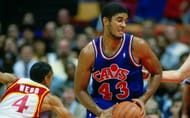
Brad Daugherty is an "old school" player compared to other players on this list, but he fits the description.
Daugherty was the first pick of the 1986 draft. The Cleveland Cavaliers selected him. The big man was one of UNC's best big men, and the Cavs hoped he continued playing well on the next level.
Daugherty was a skilled big man whose career was cut short.
In his first season with the Cavs, Daugherty averaged 15.7 points and 8.1 rebounds. Due to his performance in his rookie season, he earned an NBA All-Rookie First Team nod.
Daugherty was a big part of the Cavaliers core, as they built their team around players such as Mark Price and John "Hot Rod" Williams. The Cavs were a playoff team for five of his eight seasons.
In the 1990-91 season, Daugherty had his best season. He averaged a career-high 21.6 points and 10.9 rebounds (also a career-high). Daugherty was a talented player, but his career quickly came to an end.
Daugherty was dealing with back issues and decided to end his career at the age of 28. However, he did not make officially announce his retirement until two seasons later. Despite waiting to make the announcement, he did not play after 1993-94 (when he was 28).
The Cavaliers' big man was one of many players to be in this scenario. As the list shows, others faced similar fates.
#4 Amar'e Stoudemire
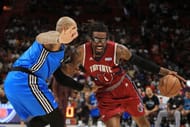
Amar'e Stoudemire was an athletic big man known for his dunking ability. He was the ninth pick of the 2002 NBA draft. The Phoenix Suns selected the 6'10" high-school prospect from Florida. He attended Cypress Creek High School before entering the league. Then, he went on to become one of the Suns' key players.
In his first season with the Suns, Stoudemire averaged 13.5 points and 8.8 rebounds. Stoudemire also played in all 82 games. His performance in his rookie season led to him winning the Rookie of the Year award, and he made the All-Rookie First Team with players such as Yao Ming and Nene Hilario.
Stoudemire's stats improved in his first three years then he suffered a setback. In his third year, Stoudemire averaged a career-high 26 points and 8.9 rebounds. In the 2005-06 season, he underwent microfracture surgery to repair knee cartilage.
He was expected to return in February but returned in March, but two games after his season debut, the Suns announced Stoudemire would miss the rest of the season due to stiffness in both knees. He played a total of three games that season.
In the 2008-09 season, Stoudemire suffered a detached retina. The injury happened in February, and he underwent surgery to repair it. He missed the rest of the season and wore protective goggles.
After retina surgery in 2008-09, Stoudemire had an 82 game season. He averaged 23.1 points and 8.9 rebounds. This was his last season with the Suns before signing with the New York Knicks.
In the summer of 2010, Stoudemire was one of many sought-after free agents. STAT was a part of a free agency class that included LeBron James, Chris Bosh, Joe Johnson, and more. Stoudemire signed with the Knicks as they hoped to add another star alongside him. This did not happen, but the Knicks signed him for five-years on a $99.8 million deal.
Stoudemire played for the Knicks for four and a half seasons. New York waived him on February 15, 2015, and the Dallas Mavericks signed him three days later. He played 23 games with them and averaged 10.8 points and 3.7 rebounds. After playing for the Mavericks, he signed with the Miami Heat in 2015.
His season with the Heat was his last season in the NBA. In the summer of 2016, Stoudemire signed a one-day deal with the Knicks. He wanted to retire with the team and went through with the short deal to make it official. He retired at the age of 33.
As of now, Stoudemire plays for the Big 3 League. The Big 3 League is a 3-on-3 league featuring former NBA stars. Stoudemire plays for "Tri-State."
Stoudemire also played in Isreal after his retirement. So, he may not be in the NBA, but he kept active afterward. Recently, Stoudemire worked out for NBA teams in hopes of making a comeback. If he gets the chance, Stoudemire could help a contending team.
#3 Gilbert Arenas
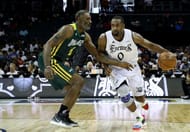
Gilbert Arenas' career started off on a promising note, and then ended on a bad one. Arenas was the 31st pick of the 2001 NBA Draft, where he was drafted by the Golden State Warriors.
Agent Zero is arguably one of the top second-round picks of all time. While he played well in college, he had to prove himself in the NBA. He wore the number zero to represent the number of minutes people said he would play in the NBA.
Arenas played two seasons with the Warriors before signing with the Wizards. In his first season, he averaged 10.9 points, 3.7assists, and 2.8 rebounds. In his second season, his stats improved significantly, and he averaged 18.3 points, 6.3 assists, and a career-high 4.7 rebounds. His performance that season led to Arenas winning the Most Improved Player award in 2003.
After his MIP win, Arenas signed with the Washington Wizards. His stint with the Wizards is where he truly made a name for himself. In his first season with the Wizards, he averaged 25.5 points and 5.1 assists. He followed up that season with a career-high 29.3 points, 6.1 assists, and 3.5 rebounds. Then, things took a turn.
In the 2007-08 season, Arenas played only 13 games (starting in eight) due to a knee injury. The following season, he played only two games. Then, in 2009, Arenas dealt with a controversial issue. That season, it was revealed that he kept unloaded firearms in his locker. It was also revealed that he and a teammate had unloaded weapons during an argument over gambling.
The NBA took action and suspended him indefinitely. He returned in the 2010-11 season and played 24 games with the Wizards before they traded him to the Orlando Magic. After a stint with the Magic, he went on to sign with the Memphis Grizzlies, which was his final NBA stop.
Arenas later signed with the Shanghai Sharks of China. He averaged 24.9 points in his only season with the Sharks. Then, Arenas retired at the age of 30.
As of now, Arenas plays for the Big 3 League. So, Arenas is still tied to the game, even if it is not the NBA.
For Arenas, injuries and controversies affected the latter years of his career. If those did not get in the way, Arenas could have remained a star.
#2 Tracy McGrady
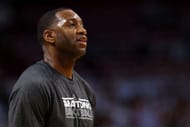
Tracy McGrady is a player who often gets the "what if" treatment. Fans often ask what he would have become if he remained healthy. Sadly, we will never know.
McGrady started his career with the Toronto Raptors. The Raptors selected him with the ninth pick of the 1997 draft. McGrady was a kid out of high-school (Mount Zion Christian Academy) with unique abilities. The Raptors picked McGrady and his cousin Vince Carter a few years later, and the two players formed a duo for a few years before splitting up in 2000. McGrady signed with the Orlando Magic, and Carter remained with the Raptors.
During his time with the Raptors, McGrady played well. Despite averaging seven points, 4.2 rebounds, and 1.5 assists in his first season, his stats improved each year. By his third season, McGrady averaged 15.4 points, 6.3 rebounds, and 3.3 assists. T-Mac's stats were solid, but it wasn't until his move to Orlando that he truly flourished.
In his first season with the Magic, McGrady averaged 26.8 points,7.5 rebounds, and 4.6 assists. His performance in this season led to him winning Most Improved Player. Then, he took off from there.
McGrady was a scoring machine that could score at will. He was a naturally gifted offensive player, and his time with Orlando reflected that. He led the league in scoring for two straight seasons. He was a scoring champion in 2003 when he averaged a career-high 32.1 points and again in 2004 when he averaged 28 points.
For the most part, McGrady stayed healthy in his time with Orlando. Then, as he went to the Rockets, injuries became a factor.
In 2004, the Magic traded McGrady in exchange for Steve Francis, Cuttino Mobley, and Kelvin Cato. McGrady played well for the Rockets but both his stats and games played per season started slowly declining. By the 2009-10 season, McGrady played six games with the Rockets (while recovering from surgery) and 24 games with the Knicks.
The Rockets traded him in a three-team deal that sent him to New York. He played with them before signing with the Detroit Pistons and Atlanta Hawks in the next two seasons.
McGrady also had a brief stint in China but did not officially retire. Shortly after his stint in China, he signed with the San Antonio Spurs just in time for their playoff run. The Spurs reached the NBA Finals that year but lost to the Miami Heat. Later that summer (in 2013), McGrady officially announced his retirement. He retired at the age of 34.
McGrady was a talented player, and if he stayed healthy, he could have been one of the greats.
#1 Yao Ming
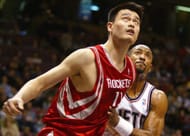
When Yao Ming entered the NBA, he was a phenomenon. Ming was a 7-foot-6 center from Shanghai, China. He played for the Chinese Basketball Association for five years before reaching the NBA.
In the CBA, he accomplished great things such as becoming MVP (both regular season and Finals) in 2001, a CBA champion in 2002, and a multiple-time rebounding and blocks leader. Ming accomplished numerous things in the CBA and eventually went on to the NBA. The NBA is where he became a massive star.
In 2002, Ming was the first pick of the NBA Draft. The Houston Rockets selected Ming, and he instantly became a cultural icon. The people of Houston loved Ming, and the people of China adored him. Ming was a skilled big man, and he put the league on notice.
In his first two seasons, Ming played 164. This means that he played all 82 games in both seasons. He averaged exceptional numbers and earned an NBA All-Rookie First Team nod in his rookie season. Ming stayed healthy in his first two seasons (and missed only two games in his third year) then injuries became a factor.
In his fourth year, Ming played 57 games. He developed osteomyelitis in the big toe of his left foot and had to get surgery to repair the injury. He underwent the procedure in December 2005 and returned after the All-Star break. However, he suffered another injury at the end of the season. The injury required six months of recovery and one of many injuries Ming dealt with. He continued to have injury-plagued seasons after that.
After his fourth year, Ming played three more (full) seasons. In the 2010-11 season, he suffered a stress fracture in his left ankle and was set to miss the rest of the season. This led to Ming making a big decision. Ming played only five games that season as his contract with the Rockets expired. At the age of 30, Ming announced his retirement.
In his early NBA career, Yao Ming was spectacular. If he remained healthy, he would have been one of the NBA's best big men/international players.
Phoenix Suns Fans? Check out the latest Suns depth chart, schedule, and roster updates all in one place.
